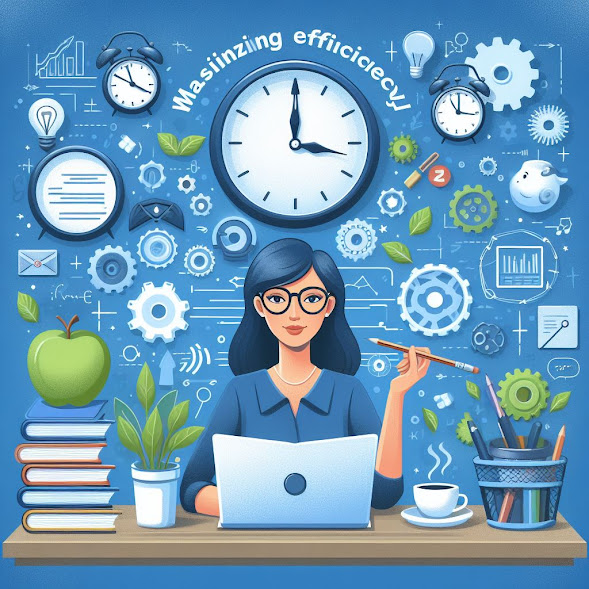In the modern classroom, technology has become an indispensable tool for educators, revolutionizing teaching practices and streamlining administrative tasks. From lesson planning to grading, technology offers a plethora of solutions designed to save time and enhance productivity for teachers. In this article, we'll explore the various ways in which technology is transforming the teaching profession and enabling educators to maximize efficiency in their daily workflows.
Streamlining Administrative Tasks
Lesson Planning Tools: Digital platforms and applications provide teachers access to a wealth of pre-designed lesson plans, instructional materials, and curriculum resources. These resources streamline the lesson planning process, allowing teachers to easily search for and customize content to meet the needs of their students.
Grading Automation: Grading assignments, quizzes, and exams can be a time-consuming task for teachers. Grading software and online tools automate this process, providing instant feedback to students and freeing up valuable time for teachers to focus on instructional planning and support. if you are a teacher click here to use the gradescalc "Test Score Calculator: for quick calculation.
Attendance Tracking: Digital attendance tracking systems simplify the process of recording student attendance, eliminating the need for manual attendance sheets. Teachers can quickly and accurately record attendance using online platforms or mobile apps, saving time and reducing administrative burdens.
Communication Platforms: Email, messaging apps, and virtual meeting platforms facilitate communication between teachers, students, and parents. These tools enable teachers to send announcements, share resources, and communicate with stakeholders in real-time, enhancing collaboration and engagement.
Enhancing Instructional Delivery
Interactive Whiteboards: Interactive whiteboards and digital displays provide dynamic visual aids for teaching and learning. Teachers can create interactive lessons, annotate content in real-time, and engage students with multimedia resources, enhancing the effectiveness of instruction.
Online Learning Platforms: Learning management systems (LMS) and virtual learning environments enable teachers to deliver course materials, assignments, and assessments digitally. These platforms provide students with anytime, anywhere access to educational resources, fostering a more flexible and personalized learning experience.
Digital Collaboration Tools: Online collaboration tools facilitate group projects, peer review, and collaborative learning activities. Teachers can create virtual workspaces, assign tasks, and monitor progress in real-time, promoting teamwork and communication among students.
Educational Apps and Games: Educational apps and games offer interactive learning experiences tailored to students' interests and abilities. Teachers can integrate these tools into their lessons to reinforce concepts, engage students, and provide personalized learning opportunities.
Leveraging Data and Analytics
Student Performance Tracking: Educational software and analytics tools provide teachers with insights into student performance, engagement, and progress. Teachers can track student outcomes, identify areas for improvement, and tailor instruction to meet individual learning needs.
Assessment Analytics: Online assessment platforms generate detailed analytics reports on student performance, allowing teachers to analyze trends, identify patterns, and make data-driven decisions about instructional strategies and interventions.
Personalized Learning: Adaptive learning platforms use data analytics to personalize instruction based on each student's learning style, preferences, and progress. Teachers can provide targeted interventions, adaptive learning pathways, and differentiated instruction to optimize student learning outcomes.
Overcoming Challenges
While technology offers numerous benefits for teachers, it also presents certain challenges that must be addressed:
Technical Issues: Teachers may encounter technical issues or disruptions when using technology tools in the classroom. Professional development and technical support ensure teachers feel confident and competent in integrating technology into their teaching practice.
Digital Equity: Access to technology and digital resources may vary among students, creating disparities in learning opportunities. Teachers must be mindful of these inequities and strive to provide equitable access to technology for all students.
Digital Distractions: Technology can be a double-edged sword, offering opportunities for enhanced learning and posing distractions that impede student focus and engagement. Teachers must establish clear expectations and guidelines for technology use in the classroom to minimize distractions and maximize learning.
Conclusion
Technology has transformed the teaching profession, offering myriad opportunities for teachers to save time, enhance productivity, and improve instructional outcomes. By leveraging digital tools and resources, teachers can streamline administrative tasks, enhance instructional delivery, and leverage data analytics to personalize learning and support student success.
However, it's essential to recognize that technology is not a substitute for effective teaching practices or human interaction. Teachers play a crucial role in guiding and facilitating student learning, and technology should be used as a complement to, rather than a replacement for, traditional teaching methods.
As technology continues to evolve and innovate, educators must adapt and embrace new tools and strategies to meet the changing needs of students and prepare them for success in an increasingly digital world. With thoughtful integration and strategic use of technology, teachers can create engaging and effective learning experiences that inspire and empower students to achieve their full potential.




.png)


